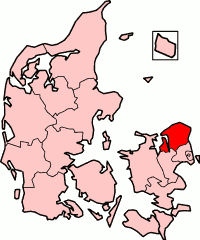Norway elects its legislature on a national level. The parliament, the Storting, has 169 members elected for a four-year term by the proportional representation in multi-seat constituencies.

Landstinget was the upper house of the Rigsdag in Denmark from 1849 until 1953, when the bicameral system was abolished. The house had powers equal to the Folketing, which made the two houses of parliament hard to distinguish.

The Danish Folketing election of 1915 was held on 7 May 1915. As required to change the Constitution, the government called for the dissolution of both the Folketing and the Landsting in order for the new Rigsdag to be able to introduce the new constitution. However, as this was during World War I, no campaigning took place, and the election was settled without voting in 104 of 114 constituencies. Therefore, it is impossible to give numbers for the actual support the respective parties received from the voters.

Folketing elections were held in Denmark on 26 April 1920, except in the Faroe Islands, where they were held on 20 May. The election campaign was the most aggressive and bitter in Denmark in the 20th century. Voter turnout was 80.6% in Denmark proper and 58.8% in the Faroe Islands.
Landsting elections were held in Denmark on 11 May 1918, with the exceptions that the seats elected by the resigning parliament were elected on 20 March 1918, the Faroese member was elected on 13 May, and the electors that elected the candidates standing in the constituencies were elected on 30 April.
The first Danish Landsting election of 1920 was held on 10 August 1920, with the exceptions that the seats elected by the resigning parliament were elected on 26 June, the Faroese member was elected on 23 August, and the electors that elected the candidates standing in the constituencies were elected on 30 July.
The second Danish Landsting election of 1920 was held on 1 October 1920, with the exceptions that the seats elected by the resigning parliament were elected on 10 September, except for the representative of South Jutland County who was elected on October 7, the Faroese member was elected on 3 February 1921, and the electors that elected the candidates standing in the constituencies were elected on 24 September 1920.
The Danish Landsting election of 1902 was held on 19 September 1902, with the exception that the Faroese candidate was elected on 6 August.
The Danish Landsting election of 1910 was held on 20 September 1910, with the exception that the Faroese candidate was elected on 1 September.
The Danish Landsting election of 1939 was held on 14 April 1939, with the exception that the electors that elected the candidates standing in the constituencies were elected on 3 April.
A referendum on the sale of the Danish West Indian Islands to the United States of America was held in Denmark on 14 December 1916. The non-binding referendum saw 283,670 vote in favor of the sale of the Danish West Indian Islands and 158,157 against. The residents of the islands were not allowed to vote on the matter, but in an unofficial vote on St. Croix arranged by David Hamilton Jackson, 4,027 voted in favor of the sale and only seven voted against. As a result of the referendum the islands were formally relinquished to the United States by the Treaty of the Danish West Indies on 31 March 1917 as the United States Virgin Islands for a sum of US$25,000,000 in gold.
The Danish Landsting election of 1924 was held on 23 September 1924, with the exception that the electors were elected on 18 September.
The Danish Landsting election of 1928 was held on 21 September 1928, with the exceptions that the electors were elected on 14 September, that the candidates elected by the resigning parliament were elected on 15 August, and that the Faroese candidate was elected on 23 August.
The Danish Landsting election of 1932 was held on 13 September 1932, with the exception that the electors were elected on 5 September.
The Bishop Auckland by-election, 1929 was a parliamentary by-election held on 7 February 1929 for the British House of Commons constituency of Bishop Auckland in County Durham.
The Danish Landsting election of 1943 was held on 6 April 1943, with the exception that the electors were elected on 23 March. Along with the corresponding Folketing election, it was the first election during the German occupation, and although many people feared how the Germans might react to the election, the event took place peacefully.

Hans Christian Steffensen was a Danish politician, jurist and speaker of the Landsting, a chamber of the parliament.
The Danish Landsting election of 1947 was held on 11 April 1947, with the exceptions that the electors were elected on 1 April 1947, that the candidates elected by the resigning parliament were elected on 7 March, and that the Faroese member was elected on 26 March.
The Cardiganshire by-election, 1932 was a parliamentary by-election held on 22 September 1932 for the British House of Commons constituency of Cardiganshire.
Events from the year 1902 in Denmark.







